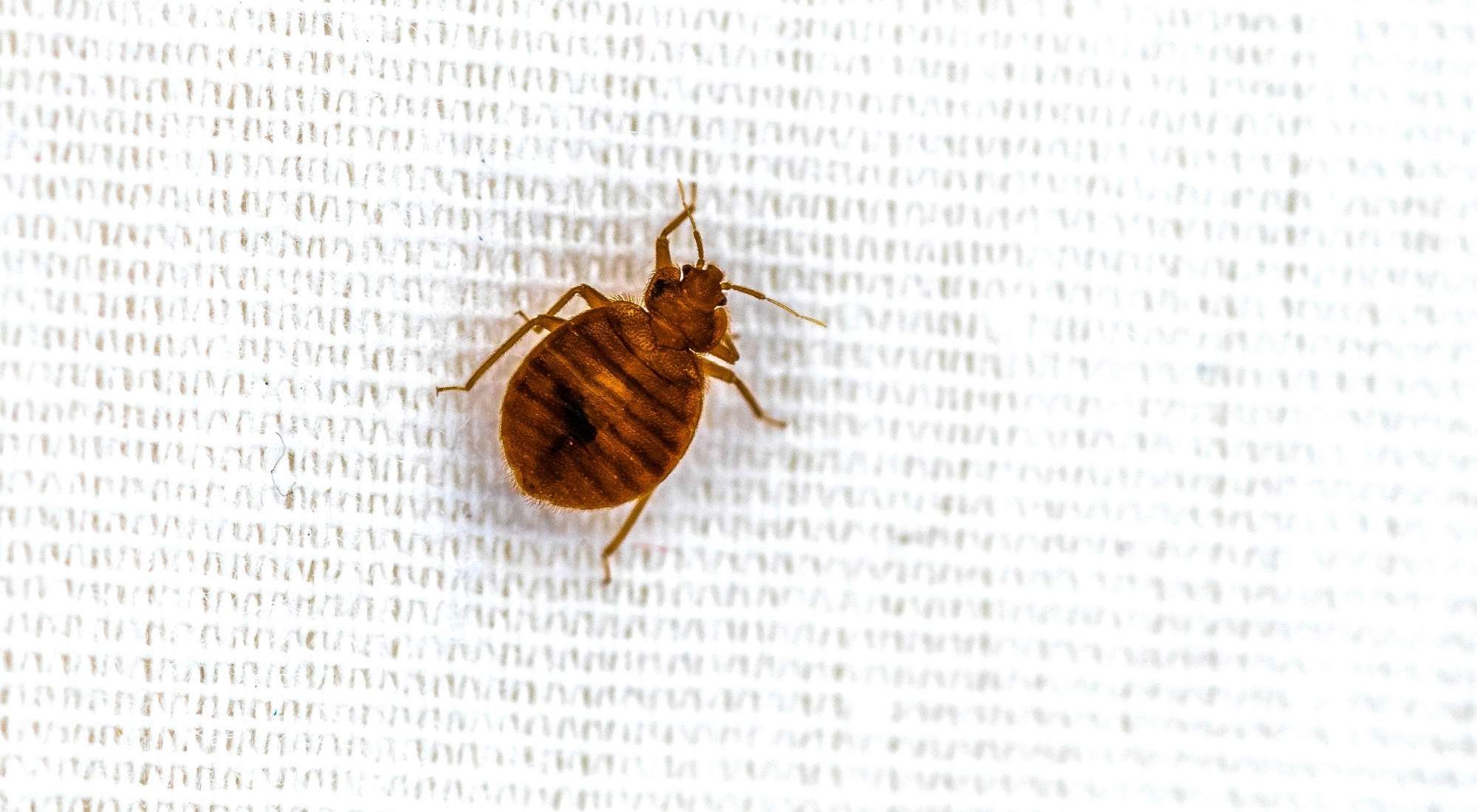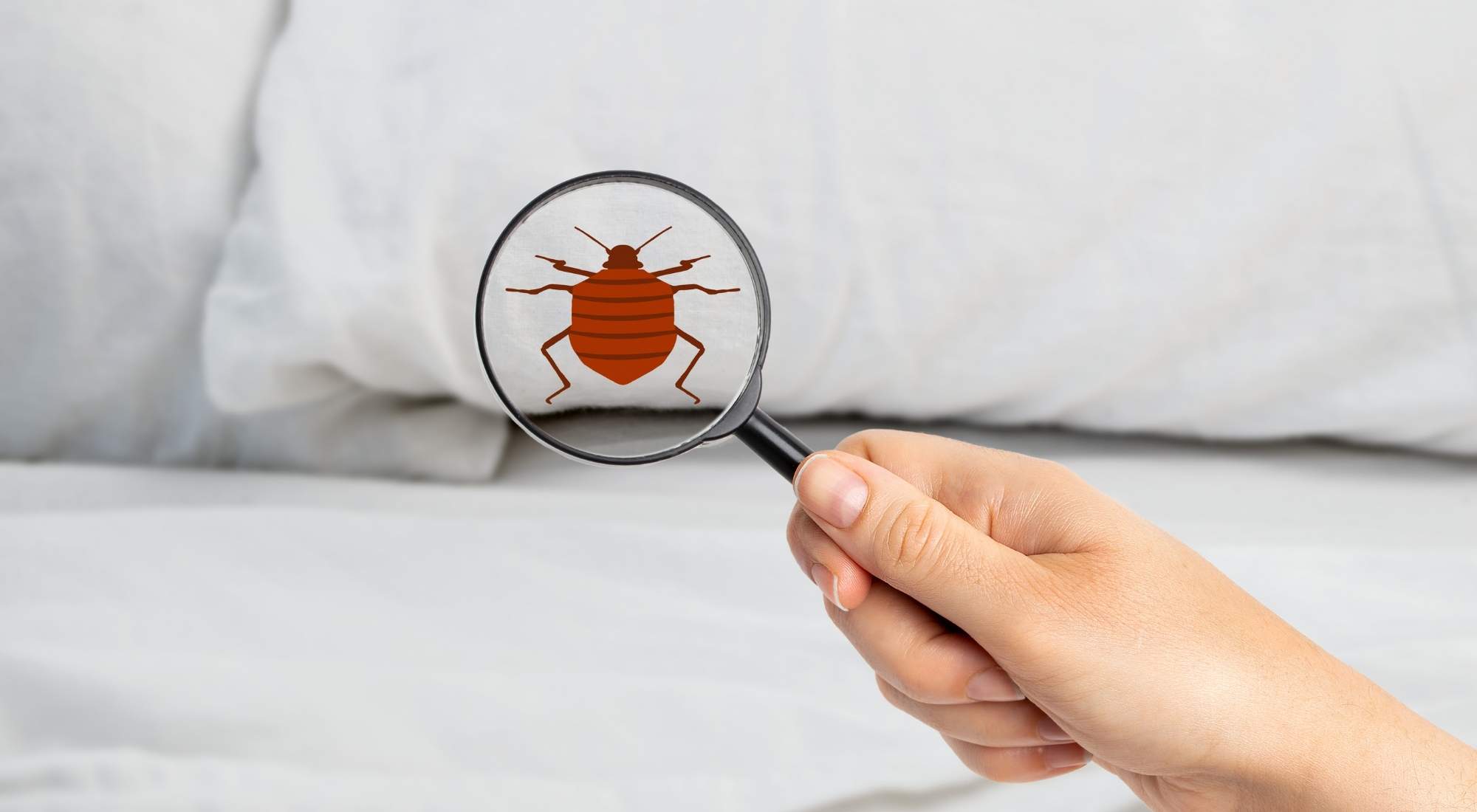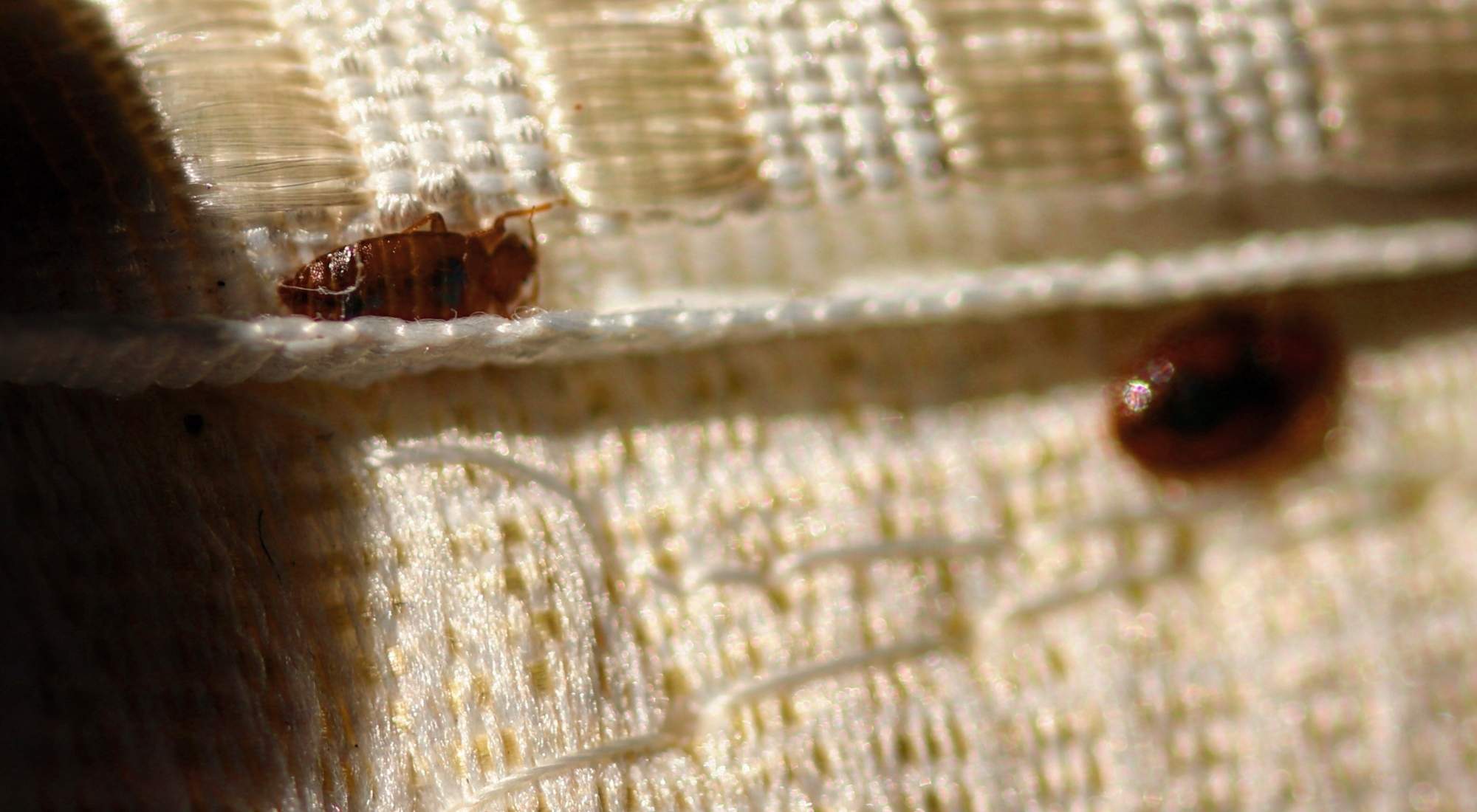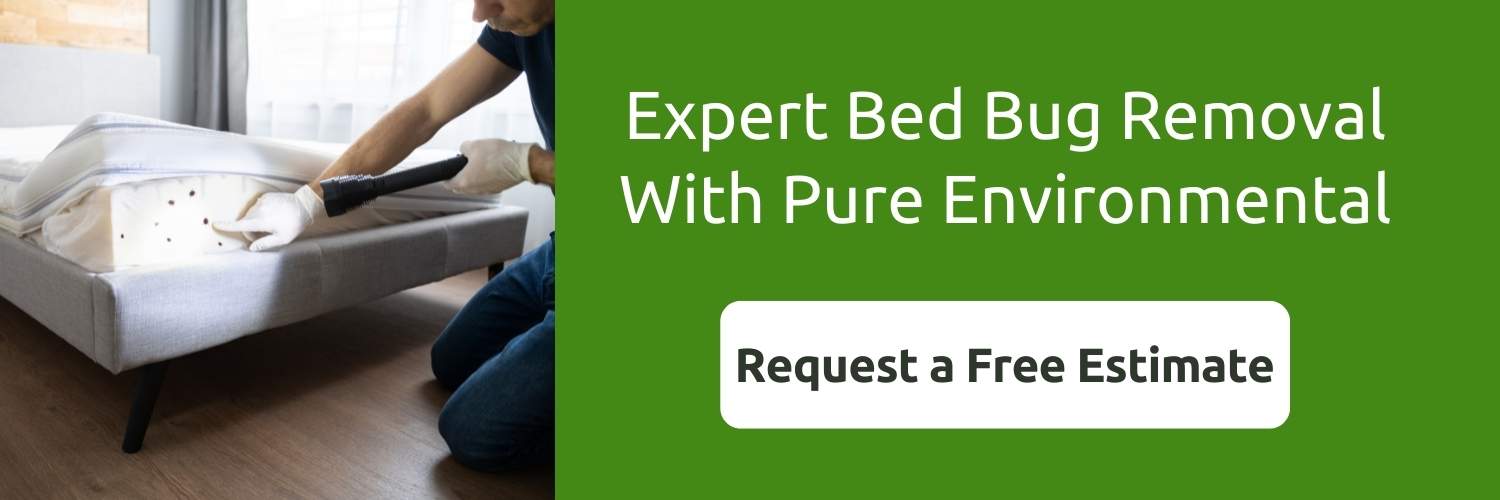Flying bed bugs.
It sounds like something out of a horror movie — and you’re freaking out about the possibility of bed bugs being in your home.
These blood suckers hide all day and attack at night. But how do bed bugs get around? Do bed bugs fly or have wings?
Even if you have bed bugs, you don’t have to worry about these creepy crawly pests turning your bedroom into a chaotic scene from a killer insect film.
Keep reading to learn exactly how bed bugs get around and what you can do about them.

Table of Contents
- Do Bed Bugs Fly?
- What Looks Like a Bed Bug but Can Fly?
- 3 Ways Bed Bugs End up in Your Home
- How To Prevent Bed Bugs From Traveling Into Your Home
- How Do You Check for Bed Bugs?
- What To Do if You Get Bed Bugs
- Pure Environmental: Professional Bed Bug Removal Services in Portland, Seattle, and Surrounding Areas
Do Bed Bugs Fly?
Don’t worry. While bed bugs are certainly annoying pests to deal with, they don’t fly.
Bed bugs (from the order Hemiptera) are wingless insects, so they aren’t capable of flying. They also aren’t good jumpers.
Bed bugs get around by crawling — and they can crawl super fast!
What Looks Like a Bed Bug but Can Fly?
Bed bugs can be mistaken for carpet beetles.
Adult carpet beetles can appear small and round like bed bugs. However, carpet beetles are much smaller and vary in color. They also have wings and can fly, unlike bed bugs.
If you’re dealing with bugs in your bedroom, the experts at Pure Environmental can help you determine what kind of bugs you have. We’re also knowledgeable about how to best get rid of them. Contact us today to schedule an inspection.
3 Ways Bed Bugs End up in Your Home
You may think (as most people do) that bed bugs are found in dirty, untidy places. But the truth is — bed bugs don’t care how clean or dirty your home is.
Bed bugs love:
- Warmth
- Blood; and
- Carbon dioxide
Even the cleanest home or the most luxurious hotel can be the perfect home for these invaders. There are many ways bed bugs find their way into homes. Keep reading to learn the most common ways.
#1: Used Furniture
You’re a thrift store junkie.
You walk into your favorite thrift store – you know, the one that never lets you down. There it is. The vintage couch of your dreams. She’s beautiful, looks clean, and the price is in your budget. Sold!
But when you buy used furniture, you can sometimes get more than you bargained for. Little hitchhikers could be hiding in the seams, waiting for the right time to get their fill.
#2: Luggage, Purses, and Bags
You’re returning home from a much-needed vacation. Work and home life got crazy, and you needed to escape for a few days.
But, you’re unknowingly bringing home a bigger stress than dealing with needy clients or sassy tweens. Bed bugs are fast, and if your hotel was hiding other guests in your room, they may have decided to stowaway in your belongings for their own vacation.
Bed bugs are experts at stowing away in luggage and can easily go unnoticed – until it’s too late. Before heading home from a vacation, be sure to thoroughly check your luggage and other personal items.
#3: Neighboring Apartments
Apartment living.
A cute little coffee shop within walking distance. No yard to mow. Affordable rent. And you don’t have to fix the broken garbage disposal yourself.
But along with the perks, can come parking issues, stairs, and pests — and not just the noisy neighbor variety.
We often think of hotels and motels being associated with bed bugs, but bed bugs don’t discriminate. Bed bugs are naturally attracted to places that have lots of people, such as apartments.
If one apartment has a bed bug problem, the entire complex is at risk. It’s important to take steps to prevent an infestation from happening to you.
If you learn a tenant has bed bugs, you should:
- Remain diligent.
- Contact your property manager or landlord immediately to inform them of the problem. Request a thorough professional inspection of your apartment. You can also check with your renter’s insurance for suggestions.
- Avoid contact with infested areas.
- Avoid the apartment that has had bed bugs unless it has been cleared by a bed bug professional.
- Inspect your apartment and belongings.
- While you wait on the professionals, inspect your home yourself. Wear gloves and use a flashlight to carefully examine your furniture and bedroom.

How To Prevent Bed Bugs From Traveling Into Your Home
Prevention is key to avoiding a costly bed bug infestation in your home. Here are our top tips for protecting your home from a bed bug invasion.
Protect Your Luggage & Check Your Hotel Room
The first thing you should do when you enter your hotel room is to stow your luggage and bags in the bathroom — and in particular, the tub.
Don’t sit any of your belongings on the bed or any upholstered chairs in the room until you’ve inspected it.
Carefully examine all the furniture in the room with a flashlight. Mattress seams, upholstered chairs, and couches are prime breeding grounds for bed bugs. You should also inspect the headboard, footboard, and any cracks or crevices. Take a good look at the sheets and blankets, especially in the folds.
Look for any signs of:
- Bed bugs
- Fecal stains – small brown or red stains: and
- Eggs – small, white, and the size of poppy seeds
If you find anything, notify the hotel staff right away and request a new room. Make sure the new room is not adjoining the infested room and give it a thorough inspection.
Once your hotel room passes the test, continue to take precautions by:
- Storing your luggage in the bathroom
- Using a luggage stand (never put luggage on the bed or floor)
- Using hooks and hangers
- Not using the hotel’s drawers or shelves
When it’s time to leave, inspect your suitcase and belongings meticulously. Place your suitcases and bags in a large black trash bag (you’ll need to bring this with you) before leaving.
Inspect your things again when you arrive home. Use a flashlight to check all compartments, pockets, and zippers in your bags.
Consider using light-colored luggage to make spying signs of bed bugs easier. And hard-sided suitcases make it harder for bed bugs to cling to and offer fewer access points.
Wash Everything in Your Suitcase
You’re home, and all seems well.
But it’s still a good idea to take extra precautions. You’re washing your clothes anyway — so take it a step further and wash and dry all your clothes (dirty or clean) on hot cycles as soon as you get home.
If washing in hot water is out of the question, use a garment hand steamer over your more fragile clothes to kill any pests that might be hiding before washing.
Just be safe, you can take your luggage outside. Use a stiff brush to scrub the bag well to help dislodge any eggs or dead bed bugs. After cleaning, vacuum thoroughly.
Inspect Used Furniture Carefully
Buying used furniture is one of the most common ways people bring bed bugs into their homes. When you buy used furniture, take a few simple household objects with you to help put your mind at ease or help you avoid an unfortunate mistake.
Your bed bug detection kit should include:
- Gloves
- Because, gross. But seriously, gloves help you get into the cracks to inspect for bed bugs. You can look for signs of pests without having to worry about anything getting on your hands.
- Flashlight
- Closely inspect your new furniture for bed bugs. While bed bugs can’t fly, they can crawl from your new furniture to wherever they think will be the best place for them to cuddle with you at night (usually your bed). Look in cracks or hidden areas where bed bugs like to hide.
- Magnifying glass
- Bed bugs can be hard to see when they’re hiding. You can see bed bugs more clearly with a large magnifying glass. This is especially helpful for newly hatched bed bugs.
- White sheet
- Wrap your new furniture in a white sheet. This will help you see any signs of bed bugs that might leave their hiding places during transport. You can also place your furniture on top of the sheet if it’s too large to wrap. You’ll be able to see them if they fall onto the sheet.
- Credit card
- Run the edge of your card firmly across the top of your new-to-you furniture to check for any signs of bed bugs. Make sure to go over any creases or cracks on the furniture’s surface. Look for feces (dark red stains) or exoskeletons.
How Do You Check for Bed Bugs?
Bed bugs are tiny. Use a flashlight and a credit card, paint scraper, or similar flat-edged object to check areas they like to hide.
Wear gloves and check for bed bugs in:
- Beds
- Furniture
- Edges of baseboards; and
- Carpet
Look for:
- Actual bugs
- Eggs
- Feces; and
- Shedded skin
What To Do if You Get Bed Bugs
If you discover you have brought home bed bugs, you’ll want to get rid of them quickly.
There are DIY remedies you can try, but they don’t always rid you of your new invaders. It’s best to seek help from a bed bug professional.
Your best chance of riding your home of bed bugs rests on:
- Early detection
- Preparedness; and
- Proper treatment methods
Experts agree that heat treatment is the most effective (and safest) method for effectively getting rid of bed bugs.
There are ways to use heat yourself, but these methods are best used for prevention and not for eradicating a bed bug problem.
If you find bed bugs in your suitcase or bags, place everything into sealed garbage bags and take it outside. Call your local bed bug exterminator right away.

Pure Environmental: Professional Bed Bug Removal Services in Portland, Seattle, and Surrounding Areas
You no longer have to wonder, “Do bed bugs fly?”
But if you suspect you have a bed bug problem, Pure Environmental is here to help. If bed bugs are the villains in your nightmares, our experts are the superheroes — helping eradicate bed bugs, one home at a time.
We use convection to force heat into:
- Mattresses
- Furniture
- Walls; and
- Other hard-to-reach-places
This method allows us to kill bed bugs — eggs, nymphs, and adults — in an environmentally friendly way. No harmful chemicals needed!
Contact us today to schedule an inspection or get a free estimate.
Recent posts
- Pros and Cons of Heat Treatment for Bed Bugs: Things To Consider When Reviewing Your Options for Remediation
- How To Get Rid of Pet Odor in Your House
- Clearing the Air: How To Clean Walls From Cigarette Smoke
- Deodorizing Your Living Space: How To Get Rid of a Musty Smell in Your House
- How Do You Get Rid of Mold in Your Attic? Tips from the Professionals
Recent Posts
- Pros and Cons of Heat Treatment for Bed Bugs: Things To Consider When Reviewing Your Options for Remediation
- How To Get Rid of Pet Odor in Your House
- Clearing the Air: How To Clean Walls From Cigarette Smoke
- Deodorizing Your Living Space: How To Get Rid of a Musty Smell in Your House
- How Do You Get Rid of Mold in Your Attic? Tips from the Professionals
